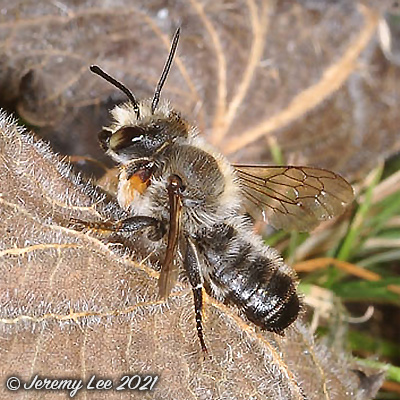
 |
|
Scientific Classifications explained » Amphibians » Ants » Aphids » Bees » Beetles » Birds » Bugs » Butterflies » Caterpillars » Damselflies » Dragonflies » Earwigs » Flies » Frog/Leafhoppers » Fungi » Galls » Grasshoppers » Harvestmen » Hoverflies » Lacewings » Ladybirds » Leaf Mines » Lichens » Mammals » Millipedes » Mosses » Moths » Sawflies » Slugs » Snails » Spiders » Trees » Wasps » Wild Flowers » Woodlice |
UK Nature > Bees > Megachile willughbiella

Scientific Name: Megachile willughbiella Common Name: Leaf-cutter Bee Megachile willughbiella, more commonly known as a Leaf-cutter Bee, is a small, solitary, leaf cutting bee. Leaf-cutter Bees nest in holes in plant stems, dead wood, cliffs or old walls, and can be seen in gardens. They famously cut discs out of leaves (they particularly like roses), gluing them together with saliva in order to build the 'cells' in which their larvae live. The larvae hatch and develop, pupating in autumn and hibernating over winter. Leaf-cutter Bees are on the wing from April to August, and feed solely on pollen and nectar; they look like Honey Bees (Apis mellifera) but the underside of its abdomen is orange. It is best recognised by its habit of carrying pieces of leaf back to its nest; semi-circular holes in the leaves of garden plants also denote its presence. There are various species of Megachile in Britain, which can be difficult to tell apart. Widespread in the UK, although less common in the north. |
|

https://www.uknature.co.uk is a website dedicated to showing the immense diversity of UK nature and wildlife. Our vast range of habitats, from lowland arable to snow covered mountains, from storm-ravaged coastlines to peaceful inland freshwater lakes and rivers, from dry, sandy heaths to deciduous and coniferous forests, all these habitats contribute to the abundance of UK nature. We have wild birds in huge numbers either residing or visiting our shores (597 recorded species as at July 2013) and we must also not forget the humble back garden with its grass lawns, flower beds filled with nectar rich flowers, shrubs and trees, all designed to attract huge numbers of insects such as bees, moths, butterflies and hoverflies; and finally the small ponds which provide safe havens for frogs, toads, newts and even slow worms and grass snakes. www.uknature.co.uk is the showcase for my personal passion, photographing uknature in all its glory. I sincerely hope you all enjoy the fruits of my labours. This site and all images contained therein is © Jeremy Lee 2004 - 2021. All Rights Reserved. Site design by Jeremy Lee. Site development & IT Support by Stuart Lee. |